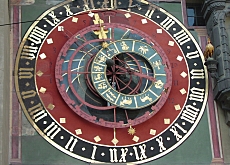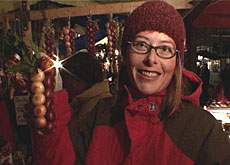
Time marches on at the Zytglogge

A visit to the landmark Zytglogge tower to watch the rooster, jester and dancing bears ring in the hour has become a must on the Bern tourist trail.
This month sees the clock tower’s 600th anniversary and swissinfo went behind the scenes to see what makes the Zytglogge tick.
Looking through the east window of the tower a few minutes before the hour, I can see little knots of tourists below, waiting expectantly for the oldest show in town to begin.
The history of the clock tower and the intricate old clock mechanism it houses provide much more food for thought than those fleeting moments of turning figures and chimes outside.
At the top of the tower is the 1.4-ton bell which gives the structure its name. The bell is engraved with the month and year it was cast – October 1405 – and has tolled every hour for the past 600 years.
The year 1405 was a turning point for Bern. The old wooden city burnt to the ground, bringing about in a massive reconstruction project, this time in sandstone. The result is the old city we know today.
Lessons in time
Christine Mosimann, our guide from Bern Tourism, incorporates a brief history of the measurement of time into the Zytglogge tour. She even explains the mysteries of the astrological clock, which is on the east side of the tower.
“The big dial on the outside gives the 24-hour measurement of the day, the star pointer gives the month and date. In the 15th century October was called Weinmonat, the month of wine,” she explains.
“The darker panels at the back indicate the time of sunrise and sunset, while another pointer shows what sign of the zodiac it is. You also have a moon pointer which shows what stage the moon is at.”
Mechanical clocks in the 15th century were the computers of their day – newfangled pieces of machinery that changed the way people lived their lives.
Twenty-four-hour clock time was developed in the 14th century and was gaining in importance in Europe around the time of Bern’s reconstruction.
The first public clocks started appearing in Europe in the second half of the 14th century. Switzerland’s first public clock in was installed in Zurich in 1368.
Intricate design
The current clock mechanism inside the Zytglogge tower replaced the original simpler mechanism in 1530.
It is a fascinating piece of machinery composed of interlocking iron wheels, ropes, levers and knobs. The large mechanism whirrs, clicks, clacks and turns constantly, the rhythm set by a giant pendulum.
The momentum for the clock is generated by gradually descending stone weights, which are hung from long ropes through three floors of the tower.
“The pendulum was added to the mechanism later and it was a real challenge to integrate it,” Mosimann says.
“Specially commissioned, highly paid experts tried and failed to do the job until the problem was eventually solved by a local farmer at the beginning of the 18th century.”
Cables leading out from different components of the mechanism set the figures in motion and control the astrological clock. Inside the tower you can watch the build-up to each element of the performance outside.
Grim history
The defence tower that had existed on the Zytglogge site since the end of the 12th century to protect the western side of the town was later overtaken by city development and was in the centre of the town by 1405.
“The tower began as a defence tower, later it was used as a women’s prison,” Mosimann explains. “So-called Pfaffendirnen (priests’ prostitutes), who were condemned for having sexual relations with priests or monks, were locked up here.”
“This was strictly forbidden and they were severely punished. Many of them died in the tower,” she adds.
The views from the tower to the east take in the old city, as first planned by Berchtold V of Zähringen with the River Aare on three sides. On a clear day you can see the Bernese Alps in the distance.
The wooden shutters of the west window open out high over Marktgasse, revealing the rest of old Bern and its inhabitants going about their business – while the Zytglogge faithfully rings out the hour.
The Zytglogge (Zeitglocken) tower and bell date from 1405.
Four minutes before every hour, the 16th-century clockwork figures on the east face of the tower come to life.
Multi-language tours take place in October at 2.30pm daily and cost SFr9 ($7) for adults and SFr4.50 for children. Special group tours can also be arranged through Bern Tourism.

In compliance with the JTI standards
More: SWI swissinfo.ch certified by the Journalism Trust Initiative






































You can find an overview of ongoing debates with our journalists here . Please join us!
If you want to start a conversation about a topic raised in this article or want to report factual errors, email us at english@swissinfo.ch.